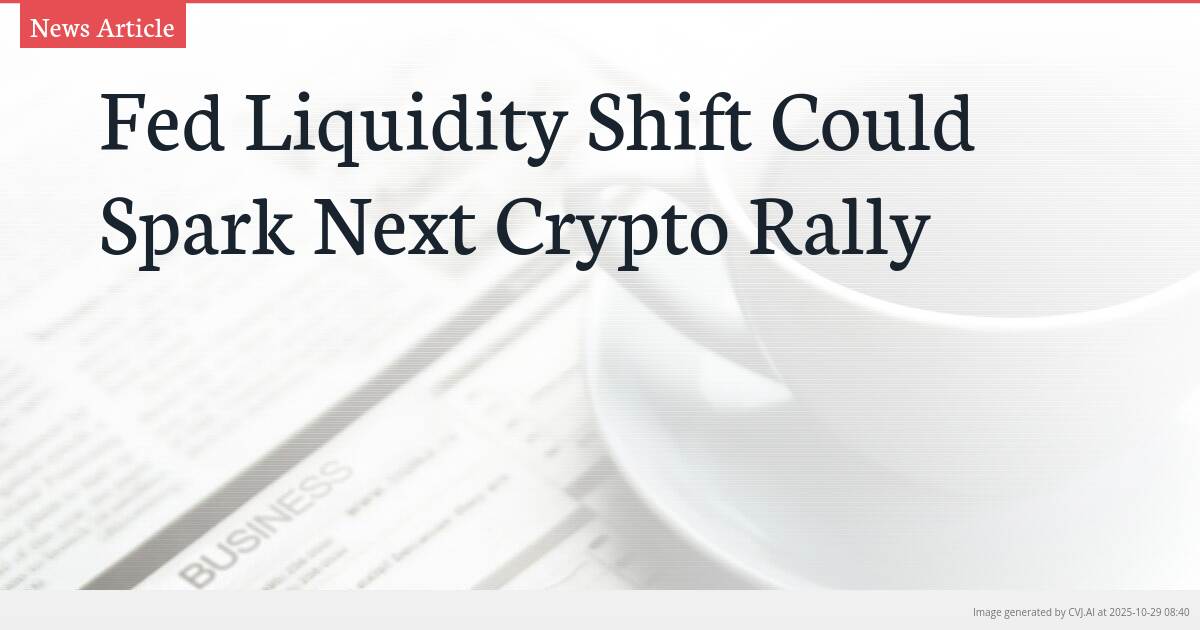This summary text is fully AI-generated and may therefore contain errors or be incomplete.
Introduction
Market expert VirtualBacon argues that Federal Reserve policy shifts, not Bitcoin halving or ETF approvals, will be the most significant crypto catalyst this year. The anticipated end of quantitative tightening and potential stealth quantitative easing could trigger major market movements. Historical patterns suggest liquidity injections directly correlate with crypto price surges, with the 2019 QT pause triggering an altcoin rally and the 2022 QT initiation coinciding with market peaks.
Key Points
- The Fed's transition from quantitative tightening to potential stealth QE could mirror the 2019 scenario where Bitcoin tripled in value following similar policy shifts
- Global M2 money supply is increasing and historically leads Bitcoin price movements by 10-12 weeks, indicating upcoming bullish momentum
- Major financial institutions including Goldman Sachs and Bank of America anticipate quantitative tightening will conclude by October 2024
The Fed's Liquidity Pivot: A Crypto Market Catalyst
According to market analyst VirtualBacon, the most significant event for the cryptocurrency industry this year isn’t the Bitcoin Halving or ETF approvals, but rather an impending shift in Federal Reserve liquidity policy. After 18 months of tightening measures, the Fed is reportedly preparing to pause its quantitative tightening program and may even initiate what experts call ‘stealth quantitative easing.’ This potential policy reversal comes as major financial institutions including Goldman Sachs, Bank of America, and Evercore all indicate that QT is nearing its conclusion, with Goldman Sachs identifying the October meeting as the base case for QT to end.
The correlation between Fed liquidity policies and crypto market performance is well-documented in recent history. VirtualBacon points to clear patterns: in 2019, when the Fed halted QT, altcoins experienced a significant rally. Conversely, in 2022, when the Fed began quantitative tightening, altcoins reached their peak before declining. Now, as the Fed is expected to end QT in 2025, market observers anticipate a similar surge for altcoins. The fundamental relationship is straightforward: when the Fed increases liquidity, altcoins tend to rise, making the timing of QT’s conclusion the critical question for crypto investors.
Fed Chair Powell recently hinted that quantitative tightening would conclude ‘in the coming months,’ signaling an imminent policy pivot. While the Fed may not explicitly label any shift as quantitative easing, VirtualBacon notes that the pivotal moment will arrive when officials remove language regarding ‘reducing the size of the balance sheet.’ This subtle change in rhetoric could have profound implications for cryptocurrency markets, potentially unlocking the next major bull cycle.
Historical Precedents and Stealth QE Scenarios
The last notable instance of a similar Fed pivot occurred during the 2019 repo crisis, when banks faced immediate cash shortages, prompting the Fed to inject $75 billion into the financial system. Although Powell claimed the intervention was ‘not QE,’ market participants recognized it as effectively being quantitative easing. Following that 2019 intervention, Bitcoin tripled in value within months, demonstrating the powerful impact of Fed liquidity operations on crypto assets.
The same indicators that caused market disruptions back in 2019 are signaling distress now, suggesting history may be repeating itself. VirtualBacon emphasizes that regardless of official statements, quantitative tightening appears to be nearing its conclusion, with stealth quantitative easing on the horizon. This shift would facilitate a return of liquidity to financial markets, which historically has served as the primary fuel for crypto price movements. The Fed, in essence, is poised to refill the market’s liquidity tank after an extended period of draining it.
The CME FedWatch tool currently reflects market expectations with a 96.7% probability of a rate cut this month and an 87.9% chance of another cut in December. These expectations align with the broader narrative of monetary policy easing, creating favorable conditions for risk assets like cryptocurrencies. The combination of rate cuts and potential quantitative easing creates a powerful dual stimulus that could propel crypto markets to new heights.
Market Indicators Point to Upward Momentum
Despite current market uncertainty, VirtualBacon asserts that Bitcoin has not reached its peak in the current cycle. Out of 30 historical indicators that typically signal a bull market peak, none have activated yet, with data indicating there is still significant room for growth. This technical analysis suggests that the current market consolidation represents a pause rather than a top, with further upside potential once liquidity conditions improve.
The global M2 money supply continues to rise, which historically leads Bitcoin prices by 10 to 12 weeks. VirtualBacon notes that since the beginning of the month, this money supply metric has been increasing, indicating that Bitcoin’s next upward movement is already in the pipeline, albeit lagging behind the liquidity curve. This relationship between money supply growth and subsequent Bitcoin appreciation provides a quantifiable framework for anticipating market movements.
Looking ahead, VirtualBacon forecasts that once the Fed officially pivots, a new altcoin season may commence. The analyst’s comprehensive view integrates monetary policy, technical indicators, and historical patterns to paint a bullish picture for cryptocurrency markets. As major institutions converge on the timing of the Fed’s policy shift and money supply metrics signal building momentum, the stage appears set for significant crypto market movements in the coming months.
📎 Read the original article on newsbtc.com

